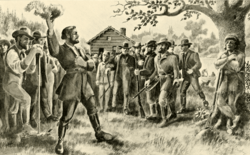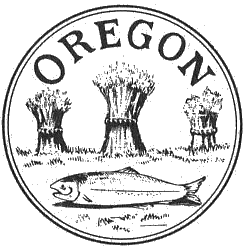Champoeg Meetings facts for kids

Joseph Meek calling for the final vote
|
|
| Date | 1841–1843 |
|---|---|
| Location | Champoeg, Oregon Country, North America |
| Also known as | Wolf Meetings |
| Participants | European-American settlers of the Oregon Country |
| Outcome | Provisional Government of Oregon established |
The Champoeg Meetings were important gatherings where early settlers in the Oregon Country tried to create their own government. These meetings happened between 1841 and 1843. They took place in a settlement called Champoeg, which is now in Oregon.
At that time, the Oregon Country was a huge area with no official government. People who lived there, like European-American and French Canadian pioneers, needed a way to make rules and solve problems. The closest thing to a government was the Hudson's Bay Company, a fur trading company. Its leader, Dr. John McLoughlin, helped keep some order.
The meetings started because a rich settler named Ewing Young died without a will. This caused problems with his property. Settlers, led by missionary Jason Lee, decided they needed a local government. They discussed how to handle property, deal with animals that attacked farm animals, and choose leaders. These discussions led to a big vote on May 2, 1843. The vote decided to form the Provisional Government of Oregon. This was a major step in Oregon's history.
Contents
Why a Government Was Needed in Oregon Country
The Oregon Country was a massive area in the Pacific Northwest. In the early 1800s, several countries claimed it, including the United States, Great Britain, Russia, and Spain. Everyone was interested in the rich natural resources, especially the fur trade. Over time, only the United States and Great Britain continued to claim the land.
Many fur trading companies tried to set up businesses there. The Hudson's Bay Company became the most powerful. They had a main base at Fort Vancouver. Even with this company, there was no official government to make laws for the growing number of settlers.
In the 1830s, missionaries also arrived. They included Protestants like Jason Lee and Catholics like François Norbert Blanchet. These missionaries and fur trappers began to settle down. They started farms and mills. By the 1840s, more and more people arrived on the Oregon Trail. Soon, there were enough Americans, Canadians, and Europeans living there. They realized they needed a real government.
Where the Meetings Happened
The main meetings took place in Champoeg. This area was known as the French Prairie. Many early settlers there spoke French. Some meetings also happened at the Oregon Institute in what is now Salem, and in Oregon City.
The name Champoeg might come from a Native American word. Or it could be a French word. The name was later used for one of the first districts of the new government.
The First Meetings in 1841
The first meetings were called in 1841 after Ewing Young died. He was a very successful rancher. He had brought many cattle from California to Oregon. This made him wealthy and connected to other settlers. But he died without a will or a family member to inherit his property. People worried that his wealth would go to the Hudson's Bay Company or the missions.
So, settlers met at Champoeg to figure out what to do. They wanted to create a plan for a government. Many important settlers attended these meetings.
The first meeting was on February 17, 1841. Jason Lee led it. He suggested creating a civil government. This government would have a governor, judges, and other officials. But François Norbert Blanchet disagreed. He suggested a simpler system with just a judge, not a governor.
At the next meeting, David Leslie was in charge. To make the French-Canadians happy, they elected Dr. Ira Babcock as the Supreme Judge. He was supposed to use New York laws to handle property issues. However, some historians say he just made decisions as he pleased. Other roles were also filled, like a court clerk and sheriffs. A committee was formed to discuss more government plans.
Later meetings were planned, but they didn't happen. The committee asked for advice from the U.S. government and the Hudson's Bay Company. Both advised the settlers to wait for their home countries to take control. This discouraged the committee. But these early meetings still helped the settlers in the Willamette Valley become more organized.
Meetings in 1842 and 1843
In 1842, settlers in Oregon City debated whether to form a temporary government or an independent country. Most people wanted to wait for the United States to take over the region.
On September 22, 1842, Dr. Elijah White held a meeting at Champoeg. He told settlers he was an agent for the U.S. War Department. He also hinted that they could choose him as a judge. But White wasn't very popular. This led to more talks about forming a government.
The "Wolf Meetings" of 1843
On February 1, 1843, settlers met at the Oregon Institute in Salem. This was called the "First Wolf Meeting." They discussed how to deal with wild animals like wolves, cougars, and bears that were attacking their farm animals. Dr. Babcock was elected chairman. He set up a committee for the "Second Wolf Meeting."
The "Second Wolf Meeting" happened on March 6 at Joseph Gervais's house. At this meeting, they created a system to pay rewards (bounties) for killing these animals. One participant, William H. Gray, said the goal was to find something everyone could agree on. This would help them protect their property and themselves. The bounties were paid by various companies and missions. This meeting also started the process of forming a provisional government, and they agreed to have a governor.
The Big Vote on May 2, 1843
The final organizational meeting was on May 2, 1843, in Champoeg. Dr. Babcock was elected President again. He called for a vote on whether to create a provisional government. This was a very important moment.
There were two votes that day. The first vote was about having a governor, which the French Canadians rejected. Then, they voted on adopting the committee's plan for a government. According to the records, a "great majority" voted to form a government.
Historians have different numbers for the exact vote count. One early account by William H. Gray said it was 52 "Americans" for and 50 "French-Canadian and Hudson's Bay men" against. However, many people at the time disagreed with Gray's numbers and his story. Another account said the vote was 55-50. The official record just says a "great majority" passed the motion.
After the vote, people elected members for a committee to write the laws for the new government. They also elected other important officials. These included Albert E. Wilson as Supreme Judge, George W. LeBreton as Court Clerk, Joseph L. Meek as Sheriff, and William H. Willson as Treasurer.
Who Voted for the Government
The list below was made many years after the vote. No official list of voters from the time of the meeting exists.
- Pleasant M. Armstrong
- Ira Babcock (president)
- Dr. William J. Bailey
- Alanson Beers
- Pierre Belleque
- J.C. Bridges
- Hugh Burns
- Charles Campo
- William Cannon
- Harvey L. Clark
- Medorem Crawford
- Amos Cook
- Allen J. Davie
- David Donpierre
- William M. Doughty
- George W. Ebbert
- Francis Fletcher
- George Gay
- Joseph Gale
- Joseph Gervais
- William H. Gray
- John Smith Griffin
- Webley John Hauxhurst
- David Hill
- Joseph Holman
- John Howard
- Gustavus Hines
- Thomas J. Hubbard
- William Johnson
- Lewis H. Judson
- George W. Le Breton
- David Leslie
- Reuben Lewis
- Étienne Lucier
- François X. Matthieu
- Joseph Meek
- William McCarty
- Charles McKay
- Robert Moore
- John L. Morrison
- Robert Newell
- James A. O'Neil
- Xavier Laderout
- Josiah Lamberson Parrish
- John Edmunds Pickernell
- James R. Robb
- Osborne Russell
- Robert Shortess
- Alvin T. Smith
- Sidney Smith
- Solomon H. Smith
- Calvin Tibbetts
- David Weston
- Caleb Wilkins
- Albert E. Wilson
- William H. Willson
Who Voted Against the Government (Allegedly)
This list was also created much later. It was based on someone's store records.
- Alexis Aubichon
- Jean B. Aubichon
- Louis Ausant
- Cyfois Bargeau
- Pascal Biscornais
- Louis Boivers
- Antoine Bonenfant
- Alexis Briscbois
- Oliver Briscbois
- Joseph Brunelle
- Andre Chalifoux
- Adolph Chamberlain
- Joseph Cornoyer
- Joseph Delard
- Pierre Depot
- Joseph Despart
- Andre Dubois
- Jean B. Ducharme
- Antoine Felice
- Louis Forcier
- Luc Gagnon
- Pierre Gauthier
- Jean Gingras
- Étienne Gregoire
- Andre La Chapelle
- Louis La Bonte
- Michel Laframboise
- Jean B. Lalcoure
- Augustin Lambert
- Alexis La Prate
- Andre Longtain
- Moyse Lore
- Joseph Matte
- Fabien Maloin
- David Mongrain
- Pierre Papin
- Pierre Pariseau
- Augustin Remon
- Thomas Roi
- Charles Rondeau
- Andre Sanders
- Gideon Senecalle
- Jacques Servant
- Louis B. Van Dalle
Creating the Organic Laws
On July 5, another meeting was held to vote on the new laws. These laws were called the Organic Laws of Oregon. They were based on laws from other parts of the United States. They set up a government with three parts, like the U.S. government. The document stated that this government would last "until such time as the United States of America extend their jurisdiction over us." This document became like Oregon's first constitution.
Instead of a single governor, they elected an Executive Committee with three members: Joseph Gale, David Hill, and Alanson Beers. The territory was then divided into four areas: Yam Hill, Clackamas, Tuality, and Champoick. These areas were generally divided by rivers. The northern border wasn't clear yet because of the ongoing land dispute with Great Britain.
What Happened Next
At first, the Provisional Government of Oregon didn't have much power. But after new laws were adopted in 1845, its control grew stronger. It started collecting taxes, building roads, and passing laws. It even fought a war against some Native American tribes after the Whitman Massacre.
In 1845, the government's power expanded north of the Columbia River. In 1846, the land dispute with Great Britain was settled. This meant the provisional government's claim was limited to the area south of the 49th parallel.
In 1848, Oregon became an official territory of the United States. The U.S. President appointed Joseph Lane as the new governor. He arrived on March 3, 1849, and officially ended the provisional government. Oregon later became the 33rd U.S. state on February 14, 1859.
Images for kids




